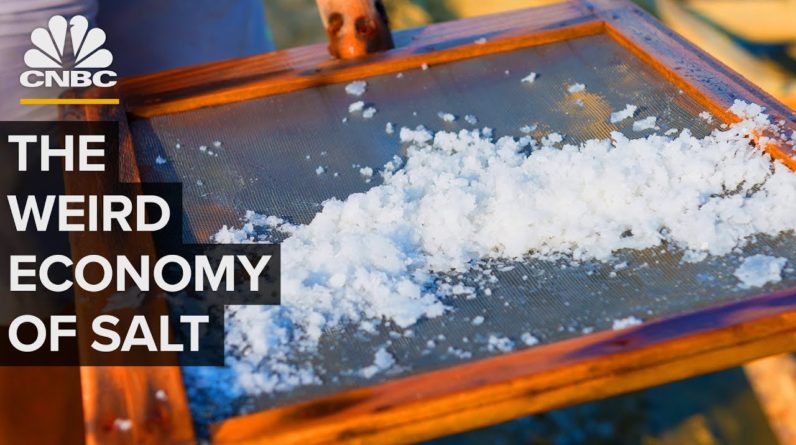
If you think about it,
salt is the foundation of our economy. Cities have
been named in its legacy. Wars fought over it. It's been taxed. It occurs naturally
nearly everywhere on earth. And at times it
was even used as money itself. Think of the
word salary. It comes from ancient
Romans that paid soldiers partially in salt. That's a political fact
of life everywhere you look. If salt gets
expensive, people get angry. There are over 14,000
different uses for salt. And in 2021, the global
salt market was worth over $13 billion. Now the US market is
dominated by three big players: Morton Salt,
Cargill and Compass Minerals. And only one
is publicly traded. Be cause Harvey Salt is a
distributor, we have the ability to procure salt
from all the major salt suppliers. So now we have a much
more concentrated industry than we've had
before. Perhaps it's a response
to how demand for salt has shifted through
history. This is an issue that
affects everybody on a daily basis. What they eat, the power
that they get, the roads that they drive on. If too much salt
permeates our environment, the effects
can be dangerous.
Here's how Salt became
one of the most game-changing minerals
in the world and what will happen if the world
keeps getting saltier. So in front of me, I
have two different kinds of salt. We have
Morton's table salt and we have Cargill's
Diamond Crystal brand de-icing salt. Both of these are 100%
sodium chloride. The biggest difference
is how they're processed. So for the table salt,
this is food grade. So it needs to be
refined for human consumption. Whereas the
de-icing salt is not produced in food grade
conditions. So you really wouldn't
want to eat this.
And most plentiful of the
ocean's treasures, salt can be taken from the
sea. Throughout history, most
salt was harvested through salt water
evaporation of some kind, and eventually good old
fashioned mining methods. However, the salt on
your dinner table, it most likely came from
solution mining. Water is pumped into
these underground salt beds, making artificial
brines. Without water, salt
pretty much looks like this. But to get it to
food grade like this, we have to use another
method. Vacuum pan. So the artificial brine
is then pumped back up into a facility above
ground where heat or both heat and a vacuum
evaporates the water, leaving the sodium
behind. This is also how the
shape of the grain can change, like your finer
table salt or a coarser pink Himalayan salt, or
even something super fancy like this really
flaky salt. The market for salt
doesn't start and end with food. Actually,
most of the salt used or sold in the US doesn't
even come from vacuum pan . We're seeing a slight
decline in food use every year.
For example, in
this chart, table salt isn't even explicitly
identified, but somewhere between food processing
and distributors like grocery stores. Table
salt is only some part of that 13% of the market. That might be because
salt in the food industry was once even more
important. Provisions to last us on
the long journey. It was needed for
preservation, not just to make food taste better. There was very little
food you could export without salt. Vegetables, meat, fish,
it all needed salt. So you could not have an
international economy if you didn't have salt. It's packed for shipment
to markets all over the world. Thanks to refrigeration. Don't worry about things
souring and spoiling this summer. And frozen food. The
electronic oven to defrost. Demand has shifted
dramatically. To this. The majority is de-icing
salt. Which is about as prosaic
a use as I could imagine.
Highway de-icing salts
accounted for about 42% of the total salt
consumed or sold in 2022. This is the largest salt
mine in the world. De-icing salt like what I
have right here primarily comes from rock salt. And US salt production is
led by rock salt at 43% of the market in 2022. So it makes sense that
most rock salt mined ends up as an ice melt
product. And since the US uses an
estimated 20 million metric tons of salt on
roads every year, governments take bids
from a bunch of companies to buy in bulk. There are governments in
the US every year that need to buy large
quantities of salt. Companies like Compass
Minerals or Morton Salt or Cargill will have to
submit bids each year for volumes and prices. So for the salt
companies, they can bid a fixed price. Then they
essentially take on the risk of can they deliver
the salt for that price and still make a good
profit. If it doesn't snow the
phones do not ring. Salt only costs pennies
per pound, but it costs dollars per bag to move
it.
It's very heavy. And rock salt is at the
lower end of the price scale for salt products,
averaging $60 per bulk unit in 2022, compared
to vacuum pan salts, averaging $230 per bulk
unit. And that makes sense,
right? The vacuum pan salt takes a lot more
time, machinery processing, you name it,
to get to that food grade status. But the largest
market for sodium chloride behind deicing
salts is chemical. It made up 39% of salt
sales in 2022. Salt is needed to
manufacture chlorine and caustic soda, which are
then used to create products like household
cleaners and plastics. So think back to this
solution mining process and the artificial brine
before it's processed. The chemical industry
uses that artificial brine as a chemical
feedstock. Of 40% salt in brine used
in 2022, most of it 91%, was used to make
chemicals.
And it's even cheaper than rock salt,
averaging $8.50 per bulk unit. Salt has a very low value
to weight ratio, meaning you can't transport it
that far to make it economically viable. So you can't really ship
salt all around the world. However, there is one
slice of the salt market that relies on plenty of
imports. Solar salt. Solar salt made up only
8% of what was used or sold in 2022. As the name suggests,
brines, including artificial brines, are
organized into ponds that are left to evaporate in
the sunlight. It's classic economics. Where else is there more
sunshine to make solar salt than somewhere a
little closer to the equator? It actually is less
costly to bring it in from the Caribbean,
where the warm waters there and the arid and
windy climate are the most conducive to
production of solar salts generated from seawater.

Solar salt is the biggest
chunk of salt imports to North America by far. We are adjacent to the
port of Baltimore, so that is where oceangoing
vessels bring in the majority of water
treatment salt, what we call solar salt, water
softener, removes the hardness ions, which can
develop scale inside the pipe. So a food
processing plant, pharmaceutical facility,
education market, K-12, hospitals, retirement
communities, nursing homes, people that use a
lot of water need to soften and condition
that water. Industries don't want
hard water that could reduce the life of
equipment. But the issue goes even
deeper than that. There is a fascinating
tension with salt in the environment because we
do need salt in our everyday lives. It's kind of like a
Goldilocks type thing. Too much or too little,
you just need the right amount. Salty water can be
dangerous. Freshwater getting
saltier is a widespread problem in the US and
globally. The problem is the
groundwater is now nearly as salty as the ocean. Some of the major rivers
and streams in the world have been showing these
increasing trends.
A third of the rivers
have become more salty in the past 25 years. Why? Because salt is
corrosive. Chloride corrodes metal. It can affect the roads
that we drive on. There's rebar metal
structures that hold roads together. And when
it interacts with that rebar, it can dissolve
the rebar and then it causes the road to
buckle. The most obvious way salt
enters the environment, the very same deicing
salts keeping our roads safe.
They're estimated
to cause anywhere from $800 to $3300 in
structural damage for every ton used,
according to the EPA. Overall corrosion of US
transportation infrastructure costs are
in the billions. Sodium chloride isn't
even the only kind of salt. Mineral salts are
abundant. You know, we think about
building up areas like with parking lots,
pavements, buildings and all that. And when they
break down, they release salts because there's
calcium and carbonate that's used to make the
built environment. It breaks down releasing
salts into the environment, which can
affect water quality. That backwashing salt
water would flow through the limestone and ruin
millions of rich producing acres. Imagine metal pipes with
saltier water flowing t hrough. Then it goes through a
whole labyrinth of pipes to homes. That salty
water can interact with the pipes and mobilize
more metals. Water with more chlorides
is going to leach metal from the wall of the
pipes, making the water corrosive. This can
create what the EPA calls salt chemical cocktails. What happens is it can't
be removed from the water treatment plant.
Instead, they try to treat it as best as they
can.
People are taking it
more seriously now because they've seen
evidence of these leaching phenomenons. What the pipes are
producing. In Flint, Michigan,
dangerous levels of lead were discovered. Flint River. It was a
complicated issue, but they had switched their
water to the Flint River, which had elevated
chlorides and corrosivity. The buildup of salt can
cause a phenomenon called the freshwater
salination syndrome. We might experience in
our everyday life corrosion of a home
appliance, a road falling apart or pipe running
rusty black water. We do take the impacts
of salt with a grain of salt and we don't know,
you know, all the impacts yet. The EPA says freshwater
salination syndrome is not easily remedied. So salt can be a problem,
but it can also be a solution. For example,
other salts are being used instead of sodium
chloride, like calcium chloride and potassium
chloride. They're substitutes for
de-icing salts, but right now they come at a
higher cost. We've seen significant
increases in the amount of ice melter that we
have sold with lower fewer chlorides in it
versus straight rock salt, which has a
significant amount of chlorides in it.
Innovation is happening
to make salt more eco-friendly. You know, then we're also
seeing new products go into de-icing salt. I think part of the
innovation that allows a coating of salt to stay
on the road longer, part of that does reduce the
runoff that goes into the water. So when salt
companies are innovating to you, say pre-storm
salt versus having to wait till it snows and
then salting the roads, a lot of that pre-storm
salt is an upgraded product that can last
through an entire storm versus having to put two
or 3 or 4 layers of salt down on the roads that
likely leads to less salt being run off in the
waterways. And some cities are
figuring out how to use less salt. Turns out,
less is more. I mean, we have a lot of
dedicated people trying to reduce salt in the
environment and they're cognizant of the
problem.
I mean, people weren't completely aware
of this issue like over the last decades. But as
more and more research has come out, they've
become more aware and they're really trying
the best that they can. It's hard to imagine a
world without salt, especially increasing
severe weather, that may result in more road salt
to keep drivers safe. In years when there are
heavy winters and there's a lot of snow, we do see
salt prices tend to rise.
But when there's winters
that are very mild, the salt producers tend to
have excess inventory that they couldn't sell
because nobody buys salt when it's not snowing. When that happens, we
see prices tend to fall. Salt was immensely
critical in shaping the world we live in today. A slab of rock salt. Transparent crystal
cubes and the kind you use on your table. So it's no surprise that
salt could transform the world ahead of us, too. It's funny because I have
a son and you watch these movies like Wall-E,
right? The last robot on Earth. It's a cute movie where
it talks about how Earth is polluted and people
have to move off of it for a while. By thinking
about how we develop versus conservation can
really do future generations a lot of
good because the more we develop the saltier the
water is going to get.







